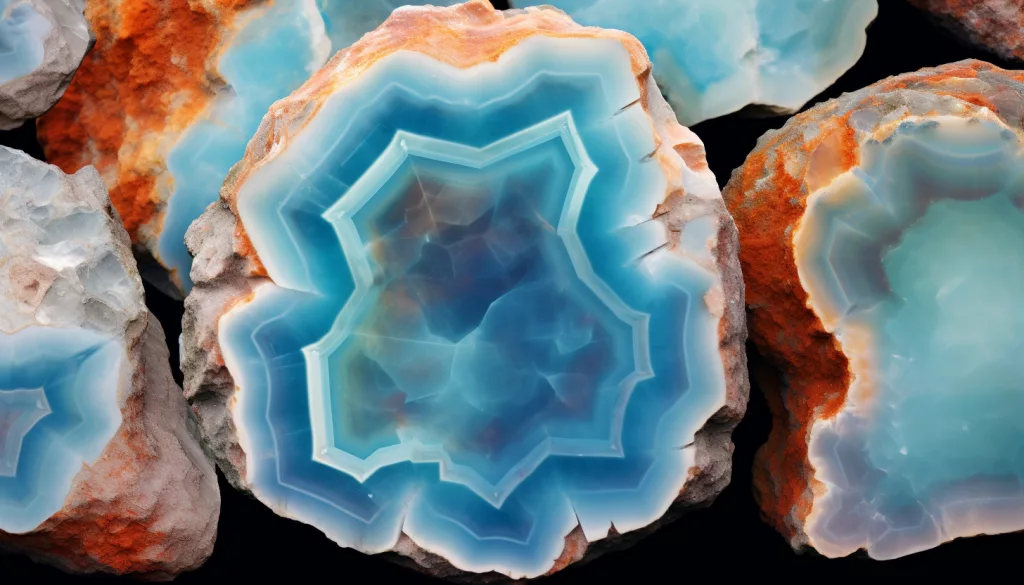

Delving into the Origins of Larimar
Larimar, a stunning and rare blue variety of pectolite, is exclusively found in the Dominican Republic. This semi-precious gemstone owes its name to Miguel Méndez, who combined the first letters of his daughter’s name, Larissa, with the Spanish word for sea, “mar.” This magnificent fusion accurately reflects the stone’s captivating colors, which range from pale sky blue to a more intense azure.
Larimar’s history dates back to the Taino Indians, who inhabited the island before the arrival of Christopher Columbus. They believed that the stone possessed divine properties and harnessed its energy to communicate with their gods. It wasn’t until the 1970s that Larimar gained global attention, thanks to the efforts of Miguel Méndez and Norman Rilling, a Peace Corps volunteer.
Unearthing the Treasures of Punta Cana
The Dominican Republic’s Los Chupaderos mining district, located near the Barahona province, is the sole source of this bewitching gemstone. Extracting Larimar is a labor-intensive process, as miners must carefully navigate the perilous terrain of the Bahoruco Mountain Range. Despite these challenges, Punta Cana offers ample opportunities for visitors to acquire Larimar jewelry and raw stones.
While in Punta Cana, we highly recommend visiting local artisan workshops, where skilled craftsmen fashion exquisite Larimar pieces. Not only will you witness firsthand the labor of love that goes into creating these remarkable works of art, but you’ll also contribute to the livelihoods of the local community. Additionally, the Punta Cana region boasts several reputable stores and markets where you can browse an extensive selection of Larimar jewelry and souvenirs.
Identifying Authentic Larimar and Steer Clear of Scams
Discerning Genuine Larimar from Counterfeits
As Larimar’s popularity grows, so does the prevalence of counterfeit stones. These fakes are usually dyed howlite or other materials that resemble Larimar’s distinct blue hues. To safeguard against purchasing imitation Larimar, consider the following factors:
- Color and patterns: Authentic Larimar exhibits varying shades of blue with white or light blue patterns. It may also have reddish-brown inclusions, which are traces of hematite. Beware of stones with artificial-looking, uniform colors or patterns.
- Translucence: Genuine Larimar has a degree of translucence, enabling light to pass through the stone. Hold the stone up to a light source to determine its translucence. If it appears opaque or plastic-like, it’s likely a counterfeit.
- Density: Larimar has a higher density than most imitation materials. Therefore, it should feel heavier than a similarly sized piece of plastic or dyed howlite.
- Price: If the price seems too good to be true, it probably is. Authentic Larimar, especially high-quality specimens, can be quite valuable. Exercise caution when encountering suspiciously low-priced Larimar products.
Choosing Reputable Dealers and Avoiding Scams
To minimize the risk of purchasing counterfeit Larimar, always buy from reputable dealers. Trusted establishments typically provide certificates of authenticity, which attest to the stone’s origin and quality. Additionally, researching reviews and seeking recommendations from locals or fellow tourists can help you identify reliable vendors.
Caring for Your Larimar Treasures
Cleaning and Maintenance
Preserving the enchanting beauty of Larimar requires proper care and maintenance. Follow these guidelines to keep your Larimar jewelry and stones in pristine condition:
- Cleaning: Use a soft, damp cloth to gently clean your Larimar. Avoid using ultrasonic cleaners or harsh chemicals, as they can damage the stone’s delicate surface.
- Storage: Store your Larimar pieces separately from other jewelry in a fabric-lined box or pouch. This prevents scratching and chipping caused by contact with harder gemstones.
- Avoiding temperature extremes: Keep Larimar away from extreme heat or cold, as sudden temperature changes can cause the stone to fracture.
- Preventing exposure to chemicals: Remove your Larimar jewelry before swimming, showering, or applying cosmetics, as prolonged exposure to chemicals can dull the stone’s luster.
Repair and Restoration
In the event your Larimar becomes damaged, seek the expertise of a professional jeweler. Skilled artisans can assess the damage and perform the necessary repairs or restoration work to revive your cherished Larimar piece.
Exploring Larimar’s Metaphysical Properties and Symbolism


Healing Energy and Spiritual Significance
Many believe that Larimar possesses potent healing energies and spiritual properties. This alluring gemstone is associated with the throat chakra, which governs communication, self-expression, and creativity. By wearing or meditating with Larimar, one can purportedly unlock these qualities and achieve a greater sense of inner harmony.
Additionally, Larimar’s connection to water and the sea symbolizes tranquility, balance, and emotional healing. Its soothing blue hues are thought to encourage calmness, reduce stress, and promote a sense of serenity. For those seeking to foster spiritual growth or strengthen their intuition, Larimar is considered an invaluable ally.
A Gemstone of the Caribbean
Larimar’s rarity and mesmerizing beauty have earned it the title of “Gemstone of the Caribbean.” Its unique appearance and captivating history make it a treasured keepsake for those who visit Punta Cana and the Dominican Republic. Whether you’re drawn to Larimar for its aesthetic appeal, healing properties, or as a memento of your travels, this extraordinary gemstone is sure to leave an indelible impression.
FAQ
Q1: What is larimar?
A1: Larimar is a rare blue variety of the silicate mineral pectolite. It is found only in the Dominican Republic, in the Caribbean.
Q2: How is larimar formed?
A2: Larimar is formed when hot gases from volcanic activity push through the limestone, carrying minerals like calcium, aluminum, and copper, which create its unique blue color. The mineral is a result of the intermingling of these elements under specific conditions.
Q3: What are the properties of larimar?
A3: Larimar is known for its striking sea-blue color, which can vary from light blue to deep blue. It has a Mohs hardness of around 4.5 to 5. The stone is often used in jewelry and is believed by some to have healing properties, although these claims are not scientifically verified.
Q4: How do you care for larimar jewelry?
A4: Larimar is sensitive to acids, heat, and strong cleaning agents. It is best to clean larimar jewelry with mild soap and lukewarm water. Avoid exposing it to direct sunlight for extended periods to maintain its color.
Q5: Is larimar a sustainable resource?
A5: Larimar is considered a non-renewable resource as it is available in a limited geographic area. There are concerns about over-mining, but steps are being taken to ensure more sustainable mining practices in the Dominican Republic.
